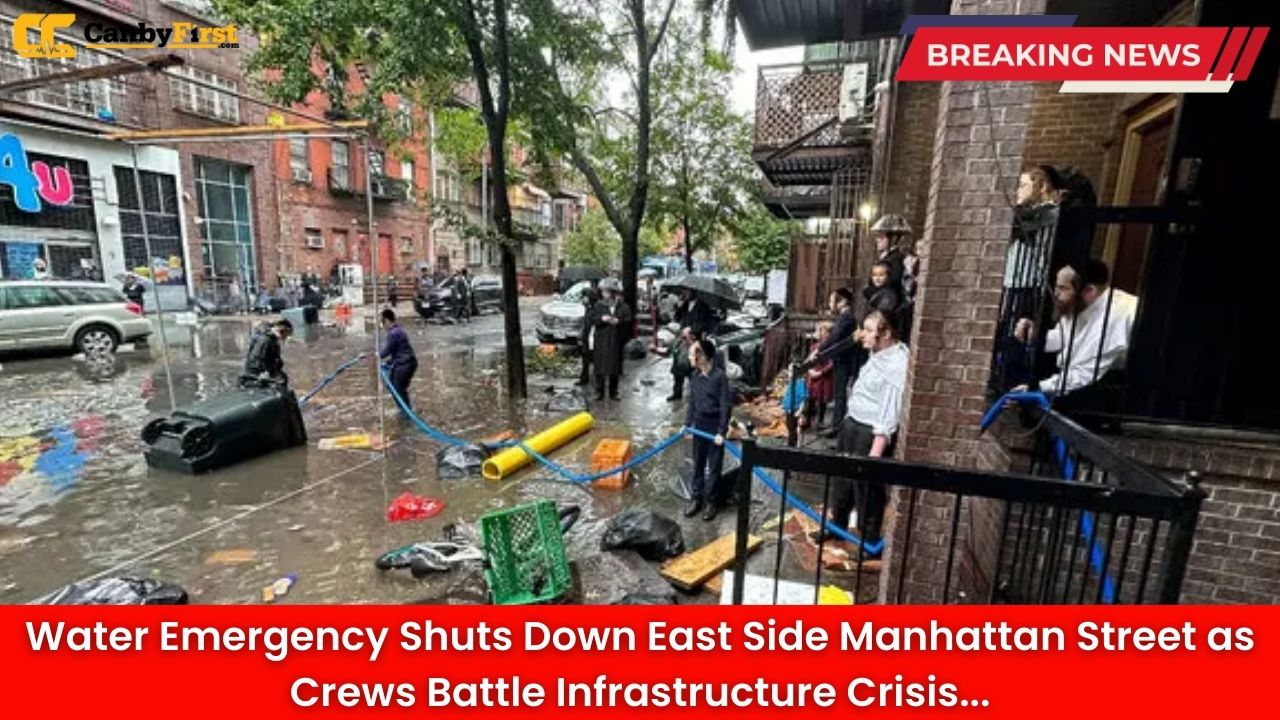New York, US: Emergency crews worked through the evening Saturday to contain a significant water main rupture that flooded portions of Manhattan’s prestigious East Side neighborhood, marking yet another incident highlighting the city’s aging water infrastructure challenges.
Immediate Response to East 51st Street Emergency
The water main break occurred around 5:30 p.m. Saturday at 455 East 51st Street, directly adjacent to the historic Beekman Mansion near Beekman Place. Emergency responders from the New York City Fire Department and Department of Environmental Protection quickly mobilized to address the situation as water erupted from beneath the pavement.
Fire Department officials confirmed that effective drainage systems prevented widespread flooding damage, with all released water successfully channeling into nearby storm drains rather than accumulating on streets or entering buildings. The swift drainage response helped minimize potential property damage in the upscale neighborhood.
Also Read
Historic Beekman Mansion Area Affected
The water main failure struck in one of Manhattan’s most distinguished residential enclaves, occurring just steps from the former Beekman family estate. The historic mansion, which opened exactly 100 years ago in 1925, now serves as a luxury cooperative building housing multiple residential units.
Beekman Place represents one of New York City’s smallest and most exclusive streets, running just two blocks between East 49th and 51st Streets. The area gained historical significance as the original site of the Beekman family’s Mount Pleasant mansion, built in 1765, where Nathan Hale was reportedly tried as a spy during the Revolutionary War.
Infrastructure Investigation Underway
Department of Environmental Protection crews immediately launched an investigation into the cause of the rupture while working to isolate the affected water main section. The agency’s response team deployed specialized equipment to assess the extent of the damage and determine repair requirements.
Officials have not yet disclosed the age of the specific water main that failed, though the incident adds to growing concerns about Manhattan’s aging water infrastructure. The city maintains over 7,000 miles of water mains throughout the five boroughs, with some sections dating back more than a century.
Broader Infrastructure Challenges
This latest water main break reflects systemic challenges facing New York City’s water distribution network. Recent data indicates that nearly 40 percent of the city’s water pipes were installed before 1941, well beyond their recommended 50-to-70-year lifespan.
The city loses approximately 155 million gallons of water daily through leaks and main breaks throughout its vast underground network – equivalent to filling 235 Olympic-sized swimming pools. These losses represent both significant resource waste and substantial economic costs for municipal water management.
Emergency Response Protocols
When water main breaks occur, the Department of Environmental Protection follows established emergency protocols designed to minimize service disruption and safety risks. Response teams typically arrive within eight hours of reported incidents, though critical situations receive immediate attention.
The agency coordinates closely with other city departments, including the Fire Department for safety monitoring and the Department of Transportation for traffic management during repair operations. Emergency repairs often require temporary street closures and may affect water pressure in surrounding buildings.
Community Impact and Safety
Saturday’s incident occurred in a densely populated residential area where any extended water service disruption could significantly impact daily life for hundreds of residents. The quick containment prevented more serious consequences that often accompany water main failures in urban environments.
Local residents reported hearing the initial rupture but praised the rapid emergency response that prevented flooding of basement apartments and ground-floor commercial spaces common in the area. The effective drainage response demonstrated the importance of maintained storm water infrastructure in limiting water main break damage.
Ongoing Infrastructure Investment
New York City has allocated substantial resources toward water infrastructure maintenance and replacement, spending $769 million on water and sewer main projects during the most recent fiscal year. However, experts estimate that replacing all aging pipes at the current pace would require more than 100 years.
The city’s Department of Environmental Protection continues implementing comprehensive asset management strategies to prioritize the most critical infrastructure improvements. These efforts focus on preventing catastrophic failures while extending the operational life of existing systems through targeted maintenance programs.
Environmental and Economic Considerations
Water main breaks create multiple environmental and economic impacts beyond immediate service disruption. Lost water represents wasted natural resources that must be replaced through the city’s complex water supply system, which draws from reservoirs more than 125 miles upstate.
Emergency repairs typically cost significantly more than planned maintenance activities, placing additional strain on municipal budgets already stretched by competing infrastructure needs. The city continues seeking federal and state funding assistance for major water infrastructure modernization projects.
Future Prevention Efforts
City officials emphasize that preventing water main breaks requires ongoing investment in both replacement programs and advanced monitoring technologies. The Department of Environmental Protection employs acoustic detection equipment to identify potential problems before they result in catastrophic failures.
However, the sheer scale of the city’s water distribution network presents enormous logistical and financial challenges for comprehensive infrastructure upgrades. Officials continue working to balance immediate repair needs with long-term system modernization goals.
Resolution and Service Restoration
Emergency crews successfully contained Saturday’s water main break and began repair operations to restore full service to the affected area. The Department of Environmental Protection coordinated with utility companies to ensure minimal disruption to other underground infrastructure during the repair process.
Residents in the immediate area were advised to expect possible temporary water service interruptions during the repair phase, though no extended outages were anticipated. The quick response and effective containment helped minimize the broader impact typically associated with major water main failures in Manhattan’s dense urban environment.
As New York City continues grappling with aging infrastructure challenges, incidents like Saturday’s water main break serve as reminders of the critical importance of sustained investment in the underground systems that support daily life for millions of residents.












